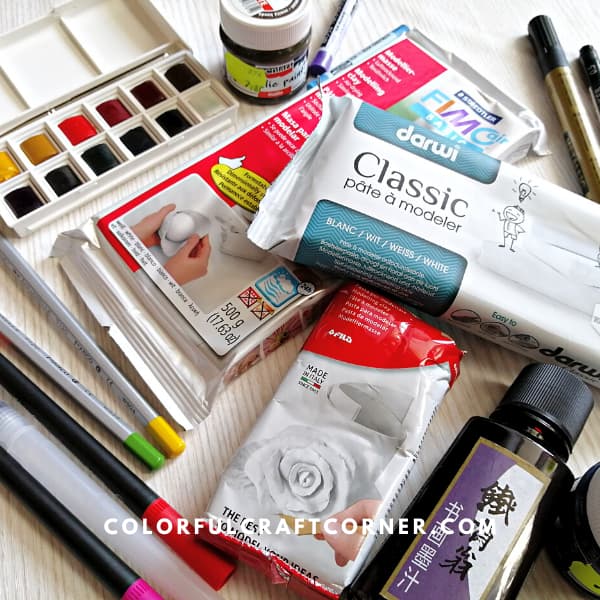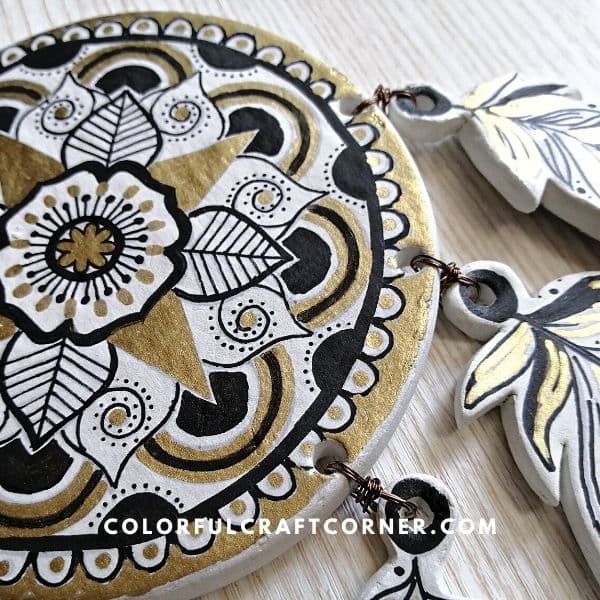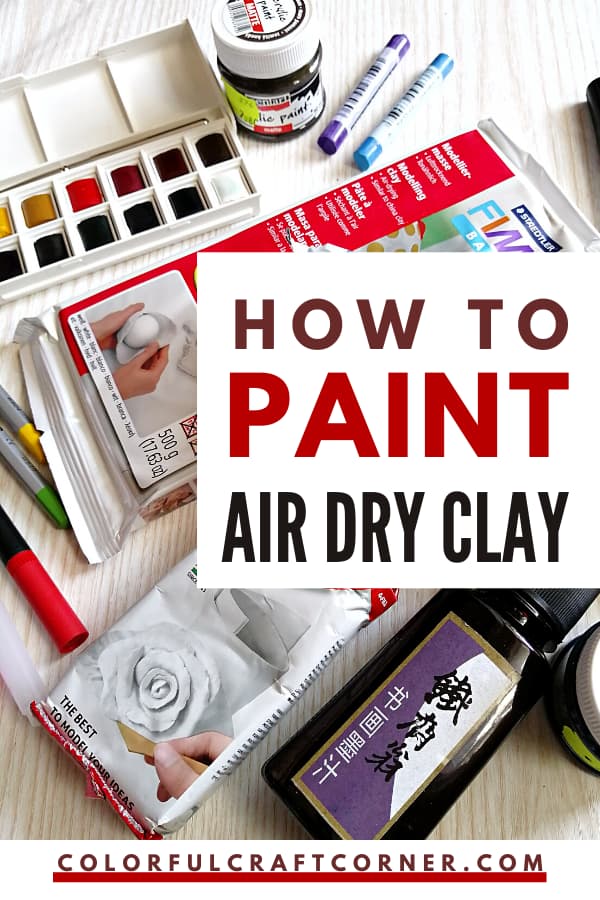What paints to use on air dry clay?
Air dry clay is an inexpensive, easy-to-use, non-toxic craft material that adults and kids love. One of the main advantages of air hardening clay is that you don’t need a kiln to cure it. Customizing clay projects is super easy with sculpting and crafting techniques and applying paint.
For best results, I will walk you through every aspect of painting your clay projects covering how to and when to apply color, the best paints for air dry clay, and other related topics.
If you still have questions, please leave a comment or send me an email, and I’ll try my best to help you.
Now, let’s dive into painting clay!
DISCLOSURE: THIS POST MAY CONTAIN AFFILIATE LINKS, MEANING I GET A COMMISSION IF YOU DECIDE TO MAKE A PURCHASE THROUGH MY LINKS, AT NO COST TO YOU. PLEASE READ MY DISCLOSURE FOR MORE INFO.
How do you paint air dry clay?
When to paint air dry clay
You can add color to your clay projects in two simple ways: applying paint after your clay project has thoroughly dried and you can make colored clay by adding pigments into the clay while still wet.
I’ll only cover the first way; to make colored clay, I have a separate post. I’ve run a simple test with several pigments to find the best one to make colored clay. Read the article on how to make colored clay.
The best way to paint on air dry clay
The best way for painting clay projects is after the craft has wholly dried, using a brush, pen, markers, or other drawing tools. Applying color to wet pieces may result in cracks and chipped paint.
Why paint chips and cracks on clay?
Wet air dry clay shrinks when drying, the paint will contract with the clay, and your beautiful design may distort, chip, crack or peel off. Also, the pigments in color can’t stick to the wet surface compared to the dried, porous pieces.

Painting tips for best results
1. Wait for the clay pieces to dry, which takes approximately 24-72 hours, based on the thickness of the clay. Maximize airflow for even drying, rotate your project occasionally. (Read more tips for drying air modeling clay projects.)
2. You need a smooth surface, so make sure to prepare it before painting. Fix cracks eliminate imperfections and rough spots with sandpaper. (Learn more about how to fix and prevent cracks on clay)
3. Dust clay pieces thoroughly after sanding using a soft brush or cloth. The tiny clay particles make the paint lumpy.
4. Apply the paint in thin coats. Wait for it to dry before applying another layer.
5. Be careful with liquid colors, like watercolors and ink. Too much moisture will weaken your craft and makes it more prone to breakage. (Learn more about the best paints in the next section.)
6. Adding a final coat of varnish to clay crafts will protect the paint. It’ll look a lot nicer and also strengthen the project.
What kind of paint do you use on air dry clay
Water-based pigments or colors are best for painting air dry clay. Acrylic paint, tempera, and guache cover projects well, but watercolors, ink, markers, and pens are also suitable to add design to clay items. Keep in mind that you must seal water-based paint after drying.
Now, let’s take a closer look at their advantages, disadvantages, and best uses when painting clay crafts.
Acrylic paint
One of the best pigments to color air dry clay is acrylic paint. It has a thicker consistency, comes in a wide range of easy-to-mix colors, and has excellent coverage. Although, you may need to thin it up with water for intricate designs or use gouache, which has a thinner consistency.
Acrylic paint creates a decorative layer when applied to the clay. It does stay on the clay, but it won’t soak into it, which can peel off or chip if not handled properly.
Best acrylic paint for air dry clay
You can buy acrylic paint in two qualities: artist-grade and student-grade. Both are suitable for painting air drying clay. Even though student-grade acrylics are cheaper, I recommend picking professional or artist-quality paints if you plan to sell your clay creations.
Professional acrylics have a higher concentration of pigments (better coverage), come in a wide range of colors, and have a smoother consistency, making them easier to blend. Check out this helpful guide on acrylic paints.
How long does it take for acrylic paint to dry on air dry clay
It may take a couple of minutes for acrylic paint to dry. Before applying a second layer, I like to leave it enough time, one or half an hour. Sometimes it seems dry when touched, but it hasn’t cured thoroughly. It happened to me several times that it stuck from the surface of one piece to another when stacked, and the paint chipped or peeled off in small spots.
Tempera
Tempera is suitable for painting air dry clay. However, I recommend acrylic paint more. Even though both dyes are water-soluble, tempera is washable after drying.
Acrylic paint lasts longer and has better pigments that retain its color for longer than tempera, which loses vibrancy after drying and gets a matte finish.

Watercolors
You can also use watercolors to paint air drying clay, but you won’t get the same effect as on paper. Clay will soak in the paint right away. You can’t use the wet-on-wet technique.
I like to use watercolors when painting air dry clay for adding subtle designs and patterns. The color will fade after they’ve dried. However, applying a coat of sealant will enliven the pigments. (As an example, check out my leaf clay dish.)
For best results, use highly pigmented watercolors and do not apply too much moisture because it will weaken your clay creation.
Gouache
You can also use gouache to paint air dry clay. Gouache is an opaque paint, making it perfect for adding illustrations to the clay pieces. It dries to a matte finish compared to acrylic paint, and water reactivates it just like watercolors. So, if you want to add layered designs or illustrations onto your clay, I would recommend using acrylic paint over gouache.
You can also combine acrylic paint with gouache to create a creamy color that covers well the painted area and can be layered too (you can also buy acrylic gouache).
I’ve found an incredible artist, Anca. She creates beautiful illustrations, and sometimes, she transfers those onto clay too. Check out her cute clay cat pins made with air dry clay and gouache paint.
Ink
Ink is also a great pigment to add designs to clay. The liquid form makes ink perfect for adding controlled, detailed, and delicate patterns and words.
You can apply ink on air dry clay in two different ways:
- Use a brush or a calligraphy pen, or a brush pen to draw on the clay piece after it has dried. For example, this wonderful clay wall hanging.
- Create a marbled effect using alcohol ink after you dried and sealed your clay items. Check out this cool marbled clay tutorial.

Pens and markers
Many pens, markers, and pencils are suitable for adding a fun design to air drying clay pieces. Make sure only to use them after the clay is bone dry. Some of them react with the sealant and bleed, ruining the design.
What kind of pen can you use on air dry clay:
- Acrylic markers are perfect and permanent on clay pieces.
- Traditional colored pencils and watercolors pencils (you can also blend them on the dried clay with a damp brush) are suitable for drawing onto dried clay.
- Gel pens are also suitable to add fine lines and intricate patterns to your clay items.
- You can add color to wet pieces with soft pastels. Take some pigment onto your finger and carefully rub onto the clay. I like to create shadows and effects with this method. (For example, this mandala trinket dish)
What you shouldn’t use to draw on air dry clay:
- Sharpies and markers designed for children bleed when you apply a varnish with a brush. You may try and experiment with other sealants, for example in a spray, or submerging the pieces in the varnish.
- Fine point, precision markers are not suitable for air hardening clay. They seem to continously dry out when drawing.
Recommendations when drawing on clay:
- Always test! Make a test pieces where you apply a tiny drawing with your prefered drawing tool and add a coat of varnish to see if they work. It’s a shame when a beautiful design bleeds in the final phase of sealing.
- Don’t push your drawing tool too hard. Air drying clay is porous and you can accidentally ‘carve’ the pieces or even break the edges if you push it too hard.
Painting and sealing air drying clay
Extend the longevity of painted clay items by applying a sealant. The varnish will prevent decoloring, protect your designs (some pigments easily wipe off), and make it stronger.
What sealant to use for painted clay?
You can pick from several types of sealants. Choose a water-based sealant, for example, an acrylic sealer. Epoxy resin is also suitable for sealing clay crafts. It is perfect to create a high-gloss finish and make it more durable.
Be aware that some sealants will change the color or the hue of your paint, making them more vivid or darker.
Some colors may bleed, so picking the proper sealant for your paint or markers is crucial. I always recommend making a ‘test piece.’ Roll out a small scrap of clay. Leave it to dry, add some doodles or just lines with your chosen paint, and seal it. And see how it goes.
I’ve learned the hard way. Several times, it happened to me that the varnish smudged the illustration on the clay. It’s annoying! You can’t fix it.
Do you need to seal air dry clay before painting?
I don’t recommend using a primer or sealant before painting air drying clay. It will make it harder to apply color. The porousness of the clay makes it ideal for the paint to adhere and stay on the clay.
How do you seal air dry clay after painting?
Before sealing painted clay, make sure that the design is arid. You can apply the varnish using a brush or wooden tool (for example, if you apply epoxy resin), pick the spray format, submerge the clay pieces into the sealant, and then let them drip off.
All of these methods are suitable. I recommend picking the one that suits your project more.
For example:
- If you need to seal a lot of pieces, use a spray varnish (outside or in a well-ventilated room) for the fastest results.
- Epoxy resin is perfect for jewelry making because you can also use it to attach clasps or stud earring backs.
- For a bushstroke-free creation, submerging is perfect, just monitor while they dry so you won’t end up with large varnish drops here-and-there.

FAQ
Can you put paint straight onto air dry clay?
You can put paint straight onto air dry clay after the piece has dried. Before applying color, I recommend sanding and dusting the surface to eliminate small bumps or other imperfections. Your painting and drawings will look better when applied to a smooth surface.
Can you paint clay while still wet?
Don’t apply paint to wet air drying clay. The clay shrinks while drying, so the color may chip and crack as the piece contracts. Also, acrylic paint may act as a sealant and lock moisture into the clay, resulting in mold, cracks, or breakage in the long run. The only way I recommend applying color to wet clay is by using soft pastels. (See my mandala trinket or heart ornaments)
Why does paint peel off of air dry clay?
Acrylic paint may peel off your air dry clay crafts for a couple of reasons: the clay is not thoroughly dry, there is dust left from sanding, the paint hasn’t dried (it takes a bit longer, it dries to touch after a couple of minutes but it didn’t adhere well), you applied a second or multiple layers too soon, bad quality paint or clay.
To keep acrylic paint from peeling off the clay, make sure everything is bone dry before applying any color, the clay is clean and dust-free. Even though I don’t think using a primer is essential when painting clay, you may try to use a thin layer, letting it cure, and apply the acrylic paint (some crafters report that this helped).
Can you stamp on air dry clay
Stamps are one of the easiest ways to add beautiful imprints to air drying clay. You can use them dry with a stamp pad or paint/ink to add colorful patterns. They are perfect for adding letters and quotes to personalize bowls, trays, plates, keychains, or other fun crafts.
Does acrylic paint make air dry clay waterproof?
Acrylic paint is known to be water-repellent after it has dried. Painting your clay crafts with acrylic paint won’t make them waterproof. Applying a sealant or epoxy resin after the color is dry will help to increase your project’s longevity but won’t make them water-resistant. Air dry clay crafts are not suitable to hold water or placed into water. They are only for decorative purposes and don’t use for food and beverages.
Can you add food coloring to air dry clay
Food coloring, acrylic paint, tempera, and other pigments are suitable to color air drying color. You can mix them into wet clay to create fantastic colors. Please consider that they will dry to a lighter shade than the original, wet one. I’ve tested and shared my experience with making colored clay in this post.
Conclusion about painting air dry clay
As you can see, there is a whole range of paints markers on other painting tools and supplies you can use to add color to your air dry clay projects. I encourage you to experiment with this wonderful craft material, but I always recommend testing, especially if it’s a craft that you intend to give as a gift.
I hope you liked this post and that I could answer a couple of questions you had regarding painting air dry clay. Feel free to leave a comment or contact me if you have other personal issues when working with clay.
Related articles on how to use air dry clay:
- How to color air dry clay
- How to dry air drying clay
- How to stop air dry clay from cracking
- How to strengthen air hardening clay
- Air dry clay tips and tricks for beginners
- How to roll out air modeling clay
- Homemade air drying clay recipes
- 10 air dry clay PROs and CONs


